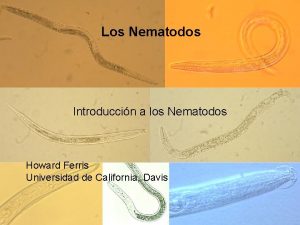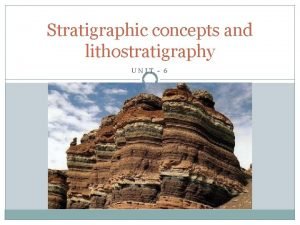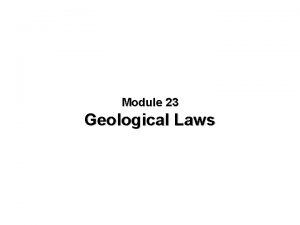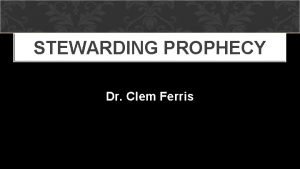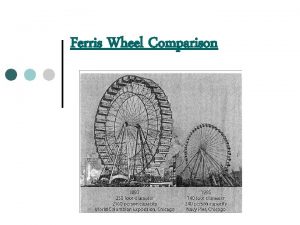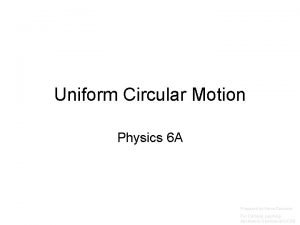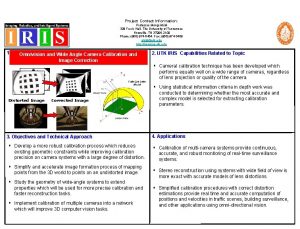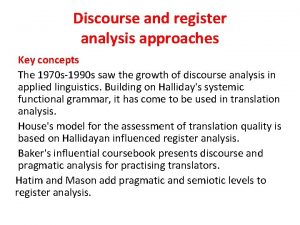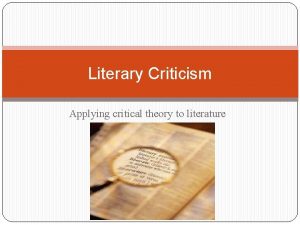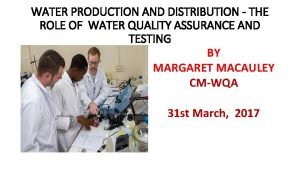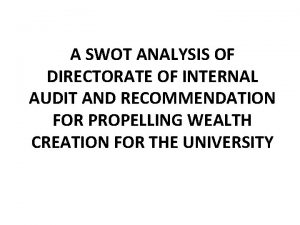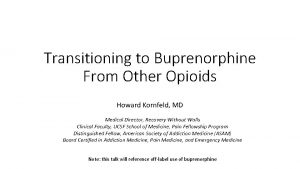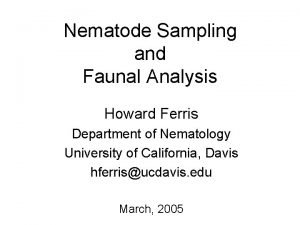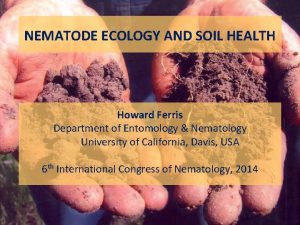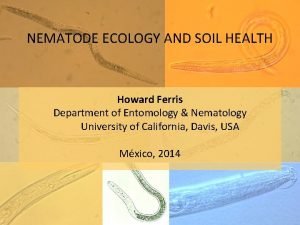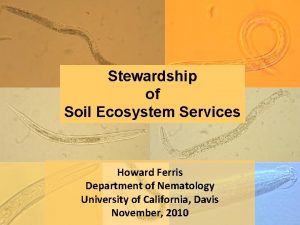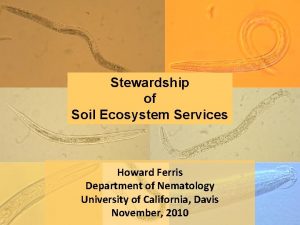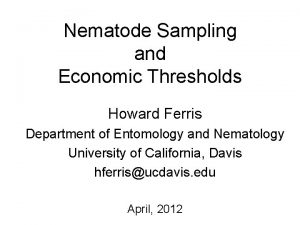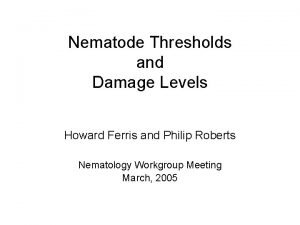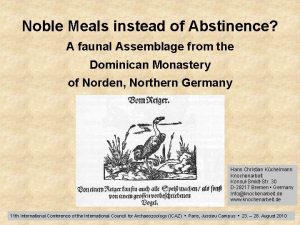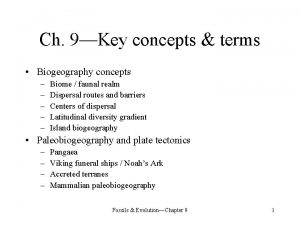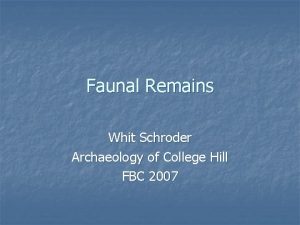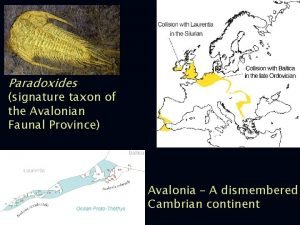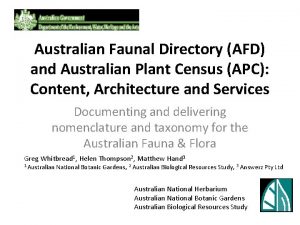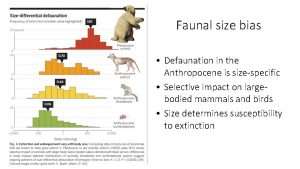Approaches in Faunal Analysis Howard Ferris Department of

































- Slides: 33

Approaches in Faunal Analysis Howard Ferris Department of Entomology and Nematology University of California, Davis hferris@ucdavis. edu April, 2012

19 th Century to mid 20 th Century recognition of abundance and habitat diversity Maupas Bastian Cobb 20 th Century to present functional diversity and bioindicator potential Ingham Wall Bongers Yeates

A milestone - calibration of ecosystem condition: Colonizer-persister Series Maturity Index = opportunism enrichment 1 structure stability 2 3 4 Bongers, T. 1990 The maturity index: an ecological measure of environmental disturbance based on nematode species composition. Oecologia 83: 14 -19. Bongers 5

Colonizer-persister series as indicator of ecosystem function opportunism structure enrichment stability 1 2 3 4 5 Structure Indicators Basal Numerator/Denominator issues: Fauna • % w 1. cp 1 = 100 w 1. cp 1 / S wi. cpi for i = 1 -5 Enrichment Indicators • It should be possible to increase structure without decreasing enrichment, and vice versa. The axes should be independent

Colonizer-persister series as indicator of ecosystem function opportunism structure enrichment stability 1 2 3 4 A question: • should the separations between the classes be equal? 5

Structure Indicator Weighting Potential Links Connectance • The relationship between trophic links and species richness 5. 0 3. 2 1. 8 0. 8 L=αS 2

Enrichment Indicator Weighting Resource availability • Food consumption necessary to achieve body weight • Mean Wt, cp 1 = 2. 68 µg • Mean Wt, cp 2 = 0. 64 µg • Differential » 4 x • cp 2 weighting = 0. 8 • cp 1 weighting = 3. 2

or es cte riv ba Enriched aje t tr Ba 1 En ric hm en • Enrichment index 100 (w 1. cp 1 + w 2. Fu 2) / (w 1. cp 1 + w 2. cp 2 ) cto r y fun giv or es Nematode Faunal Profiles Structured Fu 2 fungivores bacterivores Basal condition Fu 2 Basal Ba 2 Ca 3 Fu 3 Ba 3 Om 4 Ca 4 Fu 4 Ba 4 omnivores Om 5 carnivores Ca 5 fungivores Fu 5 bacterivores Ba 5 Structure trajectory Ferris et al. , 2001 • Structure Index = 100 wi. cpi / (wi. cpi + w 2. cp 2 ) for i = 3 -5

• Disturbed • N-enriched • Low C: N • Bacterial • Conducive Ba 1 Enriched • Maturing • N-enriched • Low C: N • Bacterial • Regulated En ric hm en t in de x Testable Hypotheses of Food Web Structure and Function • Degraded • Depleted • High C: N • Fungal Basal • Conducive Fu 2 Basal condition Structured Fu 2 Ba 2 Ca 3 Fu 3 Ba 3 Om 4 Ca 4 Fu 4 Ba 4 Structure index Ferris et al. , 2001 Om 5 Ca 5 Fu 5 Ba 5 • Matured • Fertile • Mod. C: N • Bact. /Fungal • Suppressive

Trajectory Analysis of Some California Soil Systems Enrichment Index Tomato Systems Yolo Co. Mojave Desert 100 Prune Orchards Yuba Co. 50 0 0 50 Structure Index Redwood Forest and Grass Mendocino Co. 100

How Fragile is the System? Sampled 2000 Organically-managed for 12 years Enrichment index 100 Sampled 2001 After Deep Tillage 100 50 50 Structure index Berkelmans et al. (2003) 100 0 50 Structure index 100

Assessment of Ecosystem Services There are many useful indices……. . they are based on relative abundance of taxa: • Diversity indices - Hill, Shannon-Weaver, Simpson, etc. • The Maturity Index family – Colonizer-persister series > MI Bongers, 1990 • Functional indices – Enrichment Index, Structure Index, etc. Ferris et al. , 2001

Functional There are several diversity. Diversity indices already in use A B Hoplolaimidae 5 30 Pratylenchidae 1 25 Aphelenchidae 10 30 Cephalobidae 30 5 Plectidae 25 10 Rhabditidae 30 5 Dorylaimidae 2 1 Discolaimidae 5 2 Totals 108 Hill N 0 8. 00 Simpson 0. 22 Shannon 1. 67 Hill indices N 1 5. 32 The are more usefully applied to functional guilds as 5. 32 indicators Hill N 2 of functional redundancy and functional 4. 52 complementarity. 4. 52 Horizontal vs. Vertical 0. 80 application Pielou J' 0. 80

Functional Redundancy and Complementarity Predators of Nematodes alone Full functional guild

consider biomass magnitude of each function/service?

What is the magnitude of the function or service? How much carbon is being processed? How much energy is being used? The indices are useful, but…. . … They do not indicate biomass, metabolic activity or magnitude of functions/services – so, we develop the Metabolic Footprint

per Andrássy, 1956 a) Calculated the volume of a nematode – L 1 r 1 L 2 r 2 v 1=π(L 1/3)(r 12+r 1 r 2+r 22) L 3 r 3 v 2=π(L 2/3)(r 22+r 2 r 3+r 32) v 3=π(L 3/3)(r 32+r 3 r 4+r 42) A convenient proxy… let W=2 r 3 and L=L 1+L 2+L 3+L 4 , then V = v 1+v 2+v 3+v 4 = W 2 L/1. 7 Andrássy: “I am Dr. I. Juvancz of that the of. Institute b) Determined theindebted density of to nematodes (g/m. L) as liquids of Applied Mathematics, who examined calculations. ” in which theymy float at a constant level =1. 084 Then, Mass = Volume x Density: Mass = W 2 L x 1. 084/(1. 7 x 106) μg or Mass = 0. 116 x W 2(L+3. 5 W) x 1. 084/106 μg L 4 r 4 v 4=π(L 4/3)(r 42))

Production • Nematodes differ in rates of growth • Need to adjust production estimates in relation to life course duration Ø Another proxy: cp value related to life course duration – per Bongers, 1990 Taxon Production normalized: Pt = Nt Mt/(cpt) Metabolic activity - Respiration • Use the power relationship of basal metabolism and body mass: R = c M 0. 75 If taxon biomass = Nt Mt, then: Taxon Respiration: Rt = Nt Mt 0. 75 • Metabolic Footprint = Σ (Rt + Pt) for all taxa present or for taxa representing a specific function or ecosystem service

res Nematode Faunal Profiles and the Metabolic Footprint es ba cte riv o or fun giv y cto r aje t tr Ba 1 En ric hm en • Enrichment index 100 (w 1. cp 1 + w 2. Fu 2) / (w 1. cp 1 + w 2. cp 2 ) Enriched Structured Fu 2 fungivores bacterivores Basal condition Fu 2 Basal Ba 2 Ca 3 Fu 3 Ba 3 Om 4 Ca 4 Fu 4 Ba 4 Om 5 Ca 5 Fu 5 Ba 5 omnivores carnivores fungivores bacterivores Structure trajectory Ferris, Ferris et 2010 al, 2001 • Structure Index = 100 wi. cpi / (wi. cpi + w 2. cp 2 ) for i = 3 -5

Faunal Analysis Nematode Ecology Nematode Faunal Analysis A Database of Ecophysiological Parameters in Nemaplex

The Yolo Landscape Project Sites 1 and 2 Sites 8 and 15 Yolo County, California

Nematode Fauna of a Hungarian Steppe Grassland – Péter Nagy, 1998 Four sampling dates Faunal Analysis: Functional Indices and Metabolic Footprints end of summer

45. 9 66. 3 5. 9

Economies of Ecosystems: Carbon and Energy are the Currencies CO 2 ip h s carbohydrates and proteins w e t d r a S protozoa nematodes bacteria carbohydrates C and N amino acids nematodes arthropods fungi other organisms arthropods nematodes fungi NO 3 CO 2 • Carbon is respired by all organisms in the food web Carbon and energy transfer NH 3 of Carbon and NH 3 • The amounts Energy available limit the size and activity of the web


Some References to the progression of these ideas Bongers, T. 1990. The maturity index, an ecological measure of environmental disturbance based on nematode species composition. Oecologia 83: 14 -19. Bongers, T. , M. Bongers. 1998. Functional diversity of nematodes. Appl. Soil Ecol. 10: 239 -251. Bongers, T. , H. Ferris. 1999. Nematode community structure as a bioindicator in environmental monitoring. Trends Ecol. Evol. 14: 224 -228. Ferris, H. , T. Bongers, R. G. M. de Goede. 2001. A framework for soil food web diagnostics: extension of the nematode faunal analysis concept. Appl. Soil Ecol. 18: 13 -29. Ruess, L. , H. Ferris. 2004. Decomposition pathways and successional changes. In R. C. Cook and D. J. Hunt (eds) Proceedings of the Fourth International Congress of Nematology. Nem. Monogr. Persp. 2. Brill, Netherlands. 866 p. Ferris, H. , T. Bongers. 2006. Nematode indicators of organic enrichment. J. Nematology 38: 3 -12. Sánchez-Moreno, S. , H. Ferris. 2007. Suppressive service of the soil food web: Effects of environmental management. Agric. Ecosyst. and Environ. 119: 75 -87. Ferris H. 2010. Form and function: metabolic footprints of nematodes in the soil food web. European J. Soil Biology 46: 97 -104. More information: http: //plpnemweb. ucdavis. edu/nemaplex

Ecosystem Function - Level of Resolution: Individual Taxa or Functional Guilds? • Organisms of similar ecological amplitude and sensitivities which perform the same function A B Is A an indicator of B?

An Ecosystem Service: Predation on Pest Species Predator: Prey Ratio Sanchez-Moreno et al. , 2008

Which organisms perform the suppressive service? 80 Structure index 70 60 50 r = 0. 41 40 30 20 10 0 78 83 88 Soil suppressiveness Sánchez-Moreno and Ferris, 2007. 93

Same role, different actors – successional effects June 4. 0 Tardigrades / suppressiveness R = 0. 59, p < 0. 05 3. 5 Dead / Alive Nematodes 3. 0 2. 5 2. 0 1. 5 r = 0. 73 P <0. 05 1. 0 0. 5 0. 0 October -0. 5 soil suppressiveness / tardigrades -2 r = 0. 59, P < 0. 05 Sanchez-Moreno et al. , 2008 0 2 4 6 8 10 12 14 Number of Tardigrades 16 18 20

Soil Food Web Structure - the need for indicators

The Nematode Fauna as a Soil Food Web Indicator Herbivores Bacterivores Fungivores Omnivores Predators

Enrichment Indicators Rhabditidae Panagrolaimidae etc. ¨Short lifecycle ¨Small/ Mod. body size ¨High fecundity ¨Small eggs ¨Dauer stages ¨Wide amplitude ¨Opportunists ¨Disturbed conditions Structure Indicators Aporcelaimidae Nygolaimidae etc. Basal Fauna Cephalobidae Aphelenchidae, etc. ¨Moderate lifecycle ¨Small body size ¨Stress tolerant ¨Feeding adaptations ¨Present in all soils ¨Long lifecycle ¨Large body size ¨Low fecundity ¨Large eggs ¨Stress intolerant ¨Narrow amplitude ¨Undisturbed conditions
 Anfidio
Anfidio Laterial continuity
Laterial continuity Law of inclusions
Law of inclusions Principle of faunal succession
Principle of faunal succession Ferris
Ferris Ferris wheel comparison
Ferris wheel comparison Mip ferris
Mip ferris A ferris wheel with a radius of 14m
A ferris wheel with a radius of 14m Michael himawan ferris wheel
Michael himawan ferris wheel John ferris virginia tech
John ferris virginia tech Emily fielder
Emily fielder Acuity ferris wheel
Acuity ferris wheel Karen ferris glasgow
Karen ferris glasgow Connie ferris bailey
Connie ferris bailey Ferris wheel task
Ferris wheel task Originalmarkz youtube
Originalmarkz youtube Ferris orientation
Ferris orientation Applying critical approaches to literary analysis
Applying critical approaches to literary analysis Formalist approach
Formalist approach Corpus approaches to discourse analysis
Corpus approaches to discourse analysis Register in discourse analysis
Register in discourse analysis A comparison of approaches to large-scale data analysis
A comparison of approaches to large-scale data analysis Theory of literature notes
Theory of literature notes Applying critical approaches to literary analysis
Applying critical approaches to literary analysis Swot analysis for procurement department
Swot analysis for procurement department Human resource planning introduction
Human resource planning introduction Swot analysis of hr department
Swot analysis of hr department Conclusion of swot analysis
Conclusion of swot analysis Strategy development methods
Strategy development methods Strategic planning institute
Strategic planning institute Maryland young authors contest
Maryland young authors contest Howard kornfeld md
Howard kornfeld md Sınırlı sorun çözme davranışı
Sınırlı sorun çözme davranışı Ebenezer howard
Ebenezer howard
